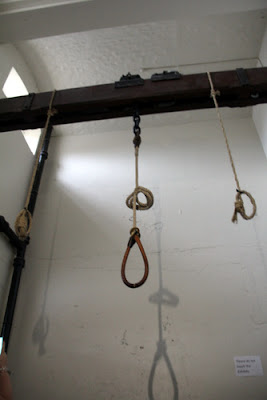After we finished the Black Cab Tour, it seemed to make sense to continue the political theme and visit the Crumlin Road Gaol. Like Kilmainham in Dublin, Crumlin Road had started as a basic prison, morphed into a political prison, and has now been shut down and serves as a tourist destination...
But this tour's a little different than Kilmainham. At least in the hands of our tour guide (who expressed a desire not to be photographed and, in particular, not to be video taped, but imagine something on the order of Megan Fox's marginally less attractive Irish cousin), the Crumlin Road tour had a lot more, shall we say, flair and enthusiasm, than Kilmainham.
Which is a little weird given the subject matter at hand.
Anyway, the tour starts in the Reception Room where new prisoners would've be brought and placed into little partitioned rooms. There they'd swap out their clothes for a loin cloth (said clothes being sanitized and stored, so the prisoner could wear them out when they left), be documented or, eventually, photographed, and then be required to bath (in 4" of water for the first fifty years or so, 9" after that) and then be put in their prison uniform.
Following this, the tour goes to the Tunnel, which connected the prison to the courthouse across the street. It's not bad now, but back in the day the courthouse was heated by boilers in the prison, and the pipes ran through the tunnel. Per the guide, it was like a sauna. Additionally, if it was raining -- and when is it not raining in Ireland? -- the tunnel would flood. So not a great place to spend time...
One interesting detail: a decade or so ago the government sold the courthouse to a private investor for the exorbitant price of one pound. The buyer claimed he had plans to turn it into a hotel, but, per our guide (who was pretty funny about it), nothing's been done since.
So now we're back in the jail. Before you get to the actual cells, you visit the Governor's (aka, Warden's) office, where you learn the (potential) origin of the phrase "being called on the carpet." It seems the only place in the entire prison with carpeting was the Governor's office. So if you were standing on carpet, it was pretty much a guarantee that it was because you'd done something wrong.
Carpet aside, now we enter the jail...
Originally, there were four wings to the jail, which housed men, women and children. Over time, the latter two categories were moved elsewhere, and it became a men's prison. But at this point, only one of the wings -- the "C" wing, mostly lately the location for ODCs ("ordinary decent criminals") -- has been restored for tourists.
However, they've configured the cells to show various eras and uses...
Including my favorite, the padded cell...
But the peak of the tour is the "condemned man's" cell, and this is where our tour guide's dramatic flair really came out. My text summation won't do it justice, but...
The condemned's cell was about three times the size of a normal cell, so the guide funnels everyone into the room and shuts the door. There's a bed, a table and chair, and a connecting door. You get the run down on visitors and last meals, and the fact that the condemned could spend as long as two weeks in this larger cell. The connecting door leads a personal bathroom -- everyone else shared -- which itself is bigger than a standard cell, and contains a toilet, sink and bookshelf.
So now the guide kicks into her dramatization of the condemned's final moments. The Governor, a priest and some guards would come into the cell. The condemned would be placed in restraints and, then, rather than moving back out into the main wing, would be directed into the bathroom. There, the bookshelf would be slid aside to reveal another door and that door thrown open (at least in our dramatic version), to reveal another room with a beam across the middle hung with a noose and a trap door in the floor.
The condemned would be moved into place, the noose put around his neck, and the release on the trap door thrown. And, yes, our guide goes through all of these steps, just as it would be done -- save with an imaginary body. (There's a glass panel across the trap now.)
According to our guide, the record for transitioning a living breathing prisoner in his dedicated room to a body hanging from the end of a rope was ten seconds.
From there, you go down the stairs to see where the body wound up. You also get to see the rack they used for flogging: up to eighteen strokes with a birch cane if you were under eighteen, or up to thirty-five strokes with a cat-o-nine-tails if you were older than eighteen.
The below ground room exits outside into the work yard. By law, the dead prisoner had to be buried on prison grounds in an unmarked grave, which at Crumlin Road meant they wound up buried next to the wall. Interestingly enough, though it was a crime to do so, scratches have been found in the wall marking where some of the executed prisoners are buried...
About ten or so years ago a law was passed allowing prisoners to be exhumed and reburied, if the family desires. It's an expensive process, though, so only two of the seventeen buried at Crumlin Road have been moved.
From there, you walk around the outside of the prison -- changes in brick color indicate expansions to the jail -- and out the front door.
All in all, a very odd experience.




















No comments:
Post a Comment
Note: Only a member of this blog may post a comment.